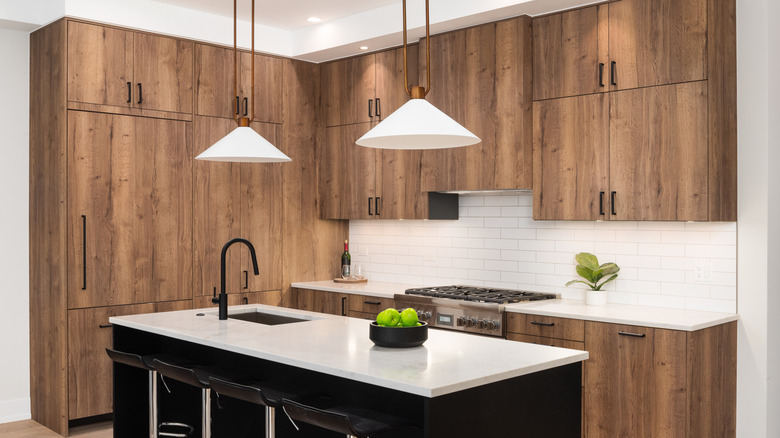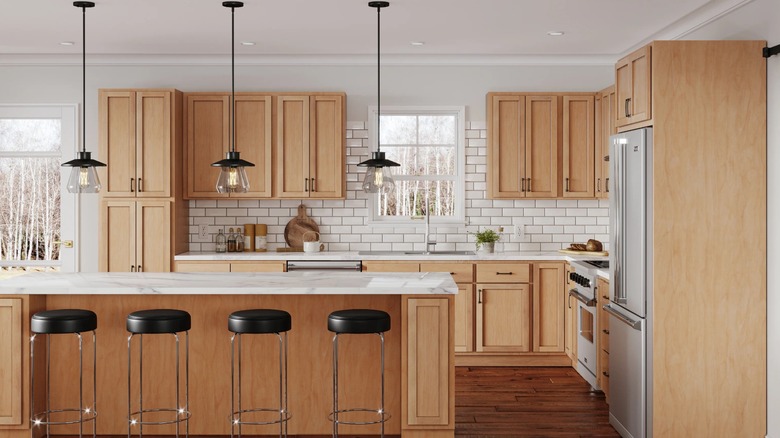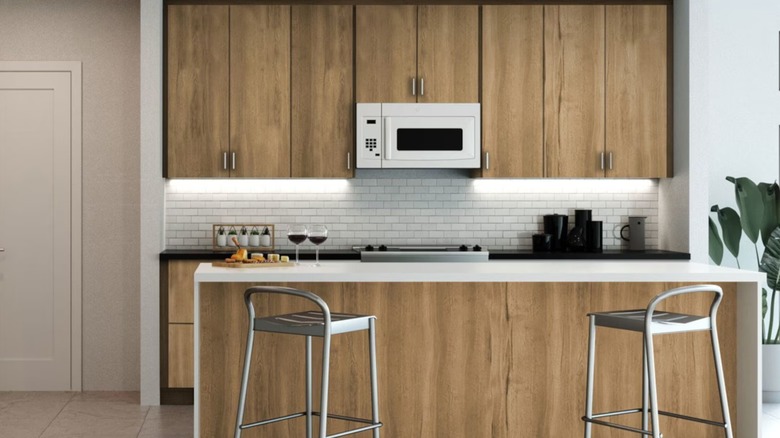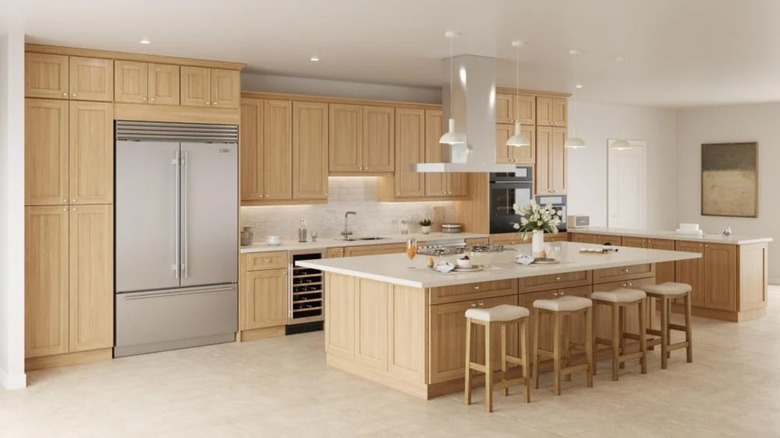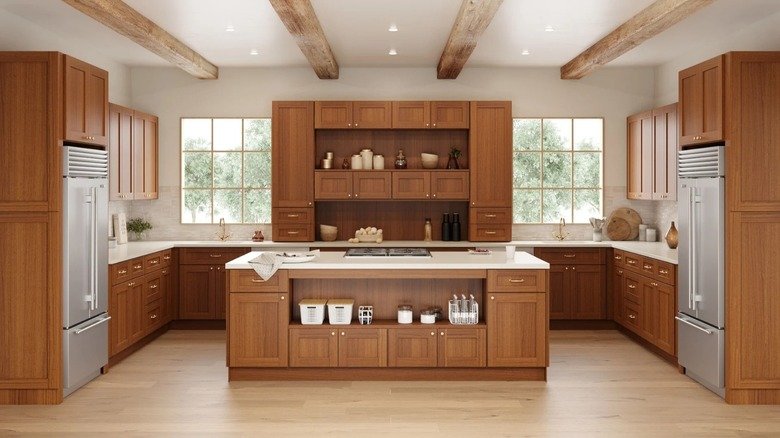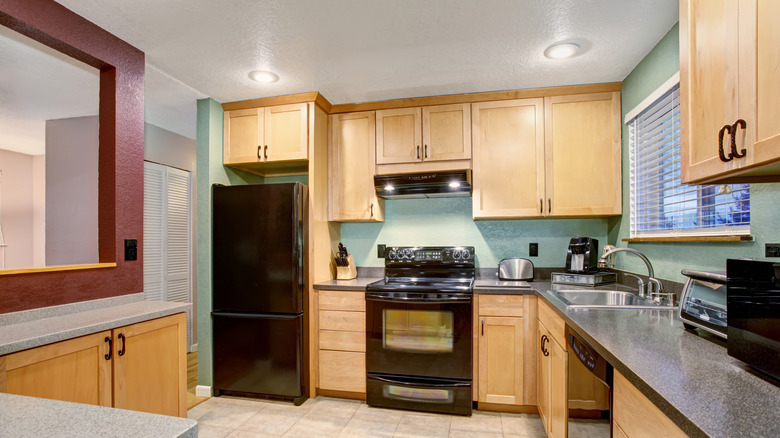What Is The Best Wood Option For Your Kitchen Cabinets?
We may receive a commission on purchases made from links.
If you're planning a kitchen remodel, your mind may be racing trying to keep track of all the decisions you need to make — from the new appliances for the space to the countertop material and color to flooring. One of the most important things you'll also need to choose is your new cabinets. The cabinets are often the most expensive part of any kitchen remodel due to the cost of the wood itself, the craftsmanship that is needed to build them, and of course, the added task of installing them. When you're investing so much already, it is essential to know the quality features to look for when purchasing new kitchen cabinetry.
One key thing you shouldn't overlook is the material of the cabinets. However, because there are so many different types of wood used for this purpose, it can be challenging to know what to choose. To help you make the best choice for your home, we spoke with several home improvement and design experts. Ahead, you can learn from their exclusive interviews with House Digest regarding which wood options are the best for kitchen cabinets.
Maple cabinets are durable, attractive, and offer an even grain
Maple is a versatile type of wood that works for a variety of home projects. And, according to our experts, one home projects should be kitchen cabinets. "Maple is the popular choice for kitchens because of its smooth, even texture and durability. It can be stained and painted beautifully, which makes it highly adaptable for purposes of design," Alecia Taylor, a designer at CabinetNow, shares exclusively with House Digest. With those smooth lines and even grain pattern, combined with the ability to stain or paint them in different shades and colors, maple cabinets can be a good choice for those looking to achieve a sleek and modern kitchen. Those looking for the best sustainable cabinet material may also want to check out maple. It is considered a sustainable wood. Trees can be found around the world, and there are also many growing right in the U.S. And compared to other species, maple trees also grow very quickly.
While there are many reasons to select maple cabinets, there are a few things to consider before finalizing your decision. First, as Alexey Beliy, the owner of HEX General Contractors, shares in an exclusive interview with House Digest, "Maple is typically more expensive than softer woods, so you'll have to budget for that." Moreover, depending on your vision for your kitchen, you might not find maple to be the best fit. As Beliy explains, "The grain is subtle, so it may look too plain for someone who wants more character." Maple is generally seen as a durable material. However, Kim Dreiling, the co-owner and designer at Kitchen Creations, shares one word of caution: "It tends to show small scratches, especially if the coating is glossy," she exclusively tells House Digest.
If you decide that maple cabinets are the right fit for your kitchen, you'll need to think about your desired finish. Natural maple offers a gorgeous look, but its color may lose its shine or start to yellow over time if exposed to too much sunlight or heat. If your kitchen gets lots of natural light, consider a finish formulated to protect against sun damage.
Oak's strong grain pattern can add character to your kitchen
As you're searching for the best wood option for your cabinets, you shouldn't overlook oak. "Oak is an old-timer — long-lasting, affordable, and full of character because it has a very strong grain. White oak is light and modern-looking, red oak has more warm tones," shares Taylor. Another benefit of oak is the flexibility it offers in terms of design options. When speaking exclusively with House Digest, Jonathan Klemm, the Founder and CEO at Quality Builders, explains, "A really good all-round option is oak because you can stain it so easily. So for most folks they can get oak and then pick a stain they like to have that 'look.'" Oak cabinets can also be more affordable than other woods, such as cherry or maple. Despite its lower price point, the wood is known for its durability and longevity. It resists wear and doesn't absorb water spills and splatters.
However, there are some things to consider before you decide on oak cabinets. "A downside is that sometimes its grain gets too strong for sleek, minimalist kitchen design," explains Taylor. And, while a coat or two of paint can fix some things, Alexey Beliy cautions against relying on that to be the best solution for oak. "It can be harder to paint, making it better for staining or just leaving natural, as-is," he says.
As you consider oak cabinets for your kitchen, don't overlook the impact the other colors and materials in the space can have. For example, there is one color you should avoid painting your kitchen if you have oak cabinets. Cool green paint can pull out the orange and yellow tones in the cabinets, decreasing the overall brightness of your kitchen. Fortunately, there are several wall colors that do pair well with oak cabinets, such as beige, gray, white, or even dusty blue. In addition to paint, another detail to consider with oak is your hardware selection. "Oak is heavy and requires high-quality hardware," explains Dreiling. Check out solid cabinet pulls and handles, such as the Ravinte Hardware Cabinet Pulls.
Choose rift-cut white oak for an elegant, high-end look
Rift-cut white oak cabinets are different from standard white oak cabinets. The uniqueness lies in the way the white oak tree is cut. For rift-sawn cabinets, a 90-degree cutting angle is used. David Peris, the owner and custom home builder at Sagrada Homes, explains how this cutting angle impacts the overall look of each cabinet, and, thus, the entire space. "Rift-cut white oak has a very defined vertical grain, which can make a kitchen feel taller and more grand," he tells House Digest during an exclusive interview. Jodi Peterman, the CEO and owner at Elizabeth Erin Designs, also appreciates the clean, vertical grain of rift-cut white oak cabinets. When speaking exclusively to House Digest, she says, "It's more expensive due to the milling process, but if a client is looking for that custom high-end appearance, this is what I present first."
The reason rift-cut white oak is more expensive is because of the amount of unusable wood that is left over after making those 90-degree cuts. Beyond the more expensive price, there are a few other potential downsides to consider before opting to add this wood to your kitchen. First, while the grain may not be as deep and defined as that of a standard oak cabinet, it is not as subtle as some other woods. "The bold grain might be too much if you're going for a sleek, minimal look," says Peris.
Depending on your design vision for your kitchen, there are different countertop and hardware combinations to consider pairing with rift-cut white oak cabinets. For example, while black cabinet pulls — such as these Ravinte Matte Black Drawer Pulls — and white natural stone countertops could deliver a more modern look, brushed nickel or silver pulls, like the Jetland Arched Hammered Cabinet Pulls, with gray or even blue countertops could help you create the farmhouse kitchen of your dreams.
As cherry cabinets age, they can add even more charm to a kitchen
Cherry is another popular wood choice for kitchen cabinets. It can deliver a gorgeous, elevated feel to a space with its darker tone combined with distinct variations in color. You can slightly alter the color of the wood with the stain of your choice, feeling confident that the result will be nice and smooth. Dreiling explains one of the reasons she often recommends cherry cabinets to her customers. She says, "Cherry is a very warm wood that ages beautifully. Over time, it darkens and acquires character." Another selling point for cherry cabinets is that they are relatively easy to care for. When needed, you can refresh the look with a fresh coat of stain or even hide any imperfections or dings with a wax filler stick, such as one of the Mohawk Finishing Products Fill Sticks.
However, as with other wood types, you'll want to weigh the pros and cons before moving forward to purchase cherry cabinets. "You need to understand that there will never be a uniform color. It's capricious and can look 'spotty,' especially on large surfaces," says Dreiling. Consider the look you desire in your kitchen — if you want something ultra-clean and sleek, cherry might not be the right fit. Additionally, as Taylor points out, "It's not as durable as hardwood, though, so it will dent or scratch more than maple or oak." Don't forget about your bottom line, either. "The biggest drawback is cost — cherry is one of the more expensive hardwoods," Jeri Goodkin-Dausey, a certified general contractor and certified building inspector at All Florida Permits, shares during an exclusive interview with House Digest.
If you decide cherry cabinets will deliver the look you desire in your kitchen, the next step will be selecting the other colors and finishes for the space. If you desire a more modern look, consider choosing a mostly white countertop and sleek stainless steel appliances. Also, take care to avoid certain paint colors with cherry wood cabinets, as their distinct reddish tone may compete with any overly bold colors or metallic hues, so it's best to stay away from these colors for your walls and other accents.
Consider the beauty of walnut to bring sophistication to a modern space
Taylor also highlights walnut as a top wood option for kitchen cabinetry. "For a rich, high-end appearance, walnut is the way to go. It's got a dark, rich finish and close grain, which works beautifully in modern and contemporary kitchens," she explains. Walnut is also resistant against moisture, which makes it a good choice for a kitchen. You won't need to worry as much about splashes around the sink or steam coming off of a hot pot on the stove. Another selling point of walnut cabinets is their long lifespan. The material is known for offering many years of use, helping you make the most of your purchase.
While Taylor speaks highly of walnut, she also acknowledges some of its downsides. "It's one of the more expensive woods to choose," she shares. If you have a high-end budget to match your high-end design goals, it could be a good choice. Otherwise, you might want to consider a different wood to achieve the overall look you desire. According to Taylor, walnut is also "softer than oak or maple and more prone to scratching." You'll need to be careful with your cabinets and accept that some imperfections are inevitable over the years. Dreiling points out one other potential consideration in regards to the size of your kitchen. "Walnut doesn't tolerate secondary roles. If the kitchen is small, it can 'take' all the attention and make the space feel heavy," she says.
The best countertop color for your walnut cabinets will vary based on your design goals and the stain of the wood. White or beige countertops that will provide a contrast against the darker wood could be a solid choice for a more modern space. Or consider a countertop material with some marbling for an upgraded look. The hardware you choose will also have an impact. Brushed nickel cabinet pulls, such as the Homidy Cabinet Handles, could deliver that modern touch, while copper pulls, like the Goo-Ki Hole Center Cabinet Pulls, might be a good fit for a more rustic kitchen.
Hickory cabinets are durable with a visible grain pattern
If durability is one of your main priorities, then hickory might be a good wood choice for you. "Hickory is extremely hard and has a strong, country look with a lot of natural color variation," explains Taylor. Cabinets made from this wood typically hold up better to the abuse many of us put our cabinets through, showing resistance against dents and dings. The reason for this resistance is because of just how hard hickory wood is. Its 1,820 rating on the Janka hardness scale is considerably higher than many other species (for example, hard maple has a rating of 1,450, while cherry's rating is only 950). In addition to being much harder than many other woods, hickory is also resistant against moisture and less likely to warp. Because of its more visible grain pattern and color fluctuations, Taylor says, "It's ideal for cabin- or farm-style kitchens."
However, hickory's visible grain that can make it a good fit for more rustic spaces may also be a potential downside for other homeowners. "Its strong grain pattern can be a bit overwhelming in some designs," explains Taylor. Moreover, she also notes that the wood's density can also make it more difficult to work with. This is part of the reason why cabinets made from it will cost more than those from many other materials — they require more labor to produce. Plus, if any repairs do come up in the future, those will likely be costlier as well.
When styling a kitchen with hickory cabinets, you should keep your overall goals in mind when choosing countertops and other finishes. A mostly solid-colored countertop will direct much of the focus to the grain pattern on the wood. You can experiment with veining or colors, but still aim to be minimal, as typically too much pattern or color will overwhelm the space.
The rustic look of alder cabinets makes them a good choice for farmhouse kitchens
There are several reasons you might want to consider alder cabinets for your kitchen. As a softer wood, alder is easier for manufacturers to work with and this often results in a lower price point. The softness of the wood and ease of workability also means that you might be able to find more customized options. Taylor shares, "Alder has a more subtle, finer grain and is generally saved for a distressed or rustic look." If a rustic look is what you're going for, then you might want to consider a lighter stain for the cabinets. This will let all of the knots and grain shine through. However, alder cabinets don't have to be reserved solely for rustic kitchens. If you choose a darker stain for the cabinets, this wood could help you create a contemporary or industrial-inspired space.
While alder's relative softness (only a 590 on the Janka hardness scale) can make it easier to work with and opens the door to more customizability, it can also be a downside. As Taylor shares, "It's going to dent and scratch more easily — something to keep in mind if you've got a heavy-traffic kitchen." Alder cabinets also won't be a good choice if you are planning on painting them a solid color. This species has more knotholes than many others. When painted, these holes may collect more of the color, resulting in an uneven appearance.
If your goal is to create a farmhouse kitchen with alder wood cabinets, then you might want to go with soapstone countertops. They can help you achieve that more rustic look without taking away from the uniqueness of the wood. Soapstone countertops are also a good choice if you're looking for something that is heat resistant.
Consider birch as a budget-friendly, yet attractive, option for a gorgeous kitchen
Two of our experts also highlighted birch as one of the best wood options for kitchen cabinets. When speaking exclusively with House Digest, Sabrina Phillips, a contractor, interior designer, and the owner of the firm Designing Women of Orange County, said, "Birch is a great option if you're looking for a budget-friendly alternative to maple. It has a smooth, even grain that's great for painted cabinets, and it takes stains nicely too." While the grain pattern on birch isn't overly bold, it also is not as uniform or regular as what you'll find with many other woods, such as maple. So, if you're looking for a material that will deliver a natural look and add some visual intrigue to your kitchen, it might be a good choice.
However, there are some downsides to consider. Goodkin-Dausey shares, "Birch takes stain well, but can sometimes absorb it unevenly, so I usually recommend it for painted cabinets or very light natural stains." Phillips echoes this advice, noting that if you choose a dark stain, the finish might look blotchy. She highlights the importance of preparing the surface properly if you are going to stain birch, particularly with a darker finish. Phillips expresses another downside to keep in mind: "Since it's not as dense, it's a little more prone to dings, but it's a solid choice if you're balancing style and cost."
As both Goodkin-Dausey and Phillips discuss, the stain color is something you'll want to closely consider if you choose birch cabinets. Because of its natural color and unique grain pattern, the wood itself can nicely complement a modern kitchen. Perhaps simply apply a satin finish to let that grain pattern shine through. Going this route would also avoid the potential trouble with darker stains that both experts cautioned against. To finish off the modern look, consider adding sleek matte black cabinet pulls, such as the Goo-Ki Modern Cabinet Pulls.
